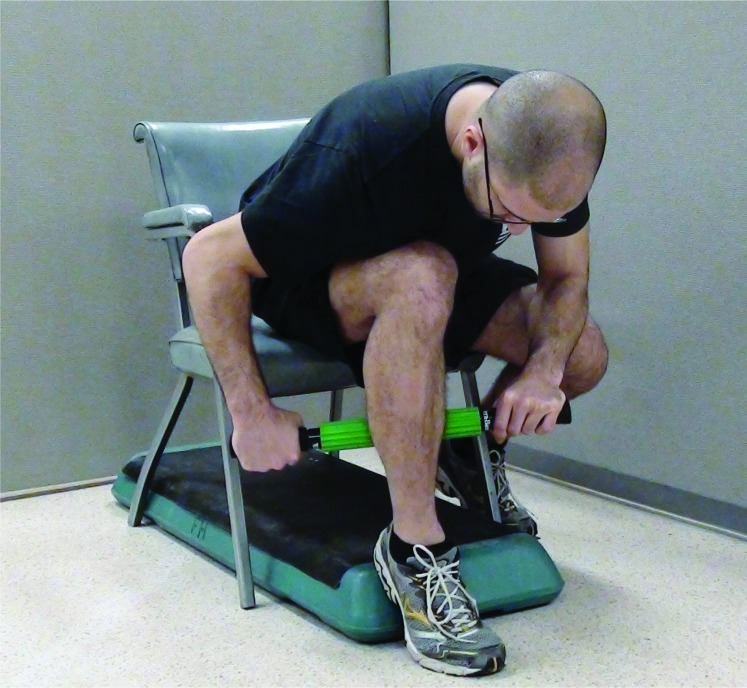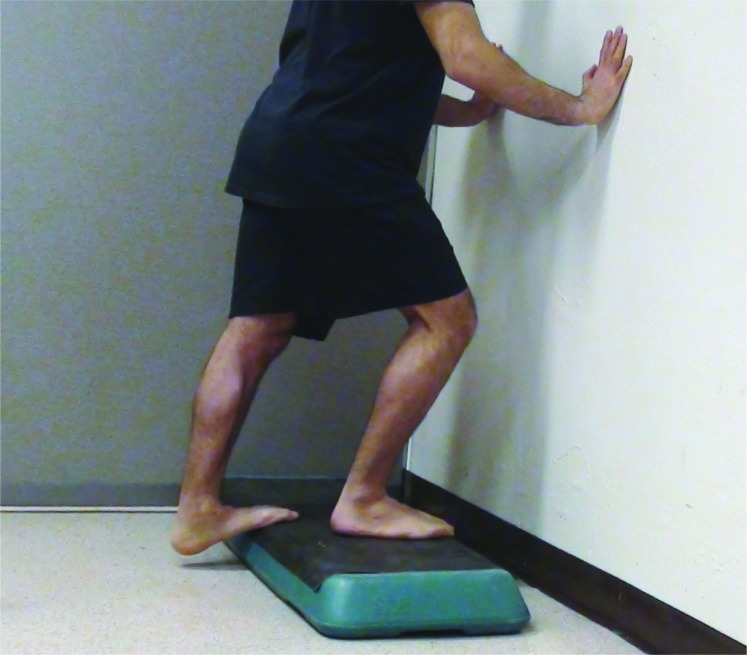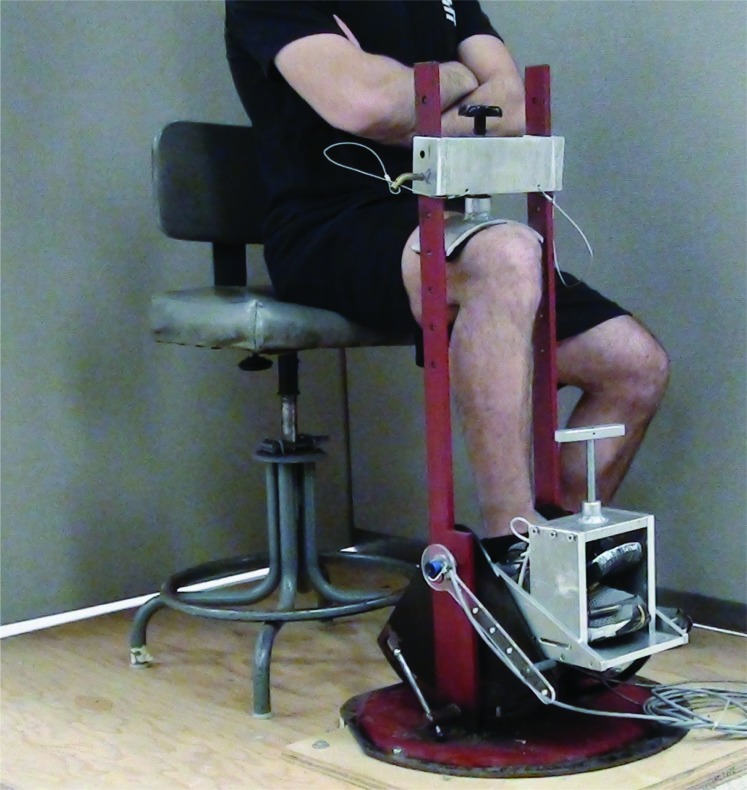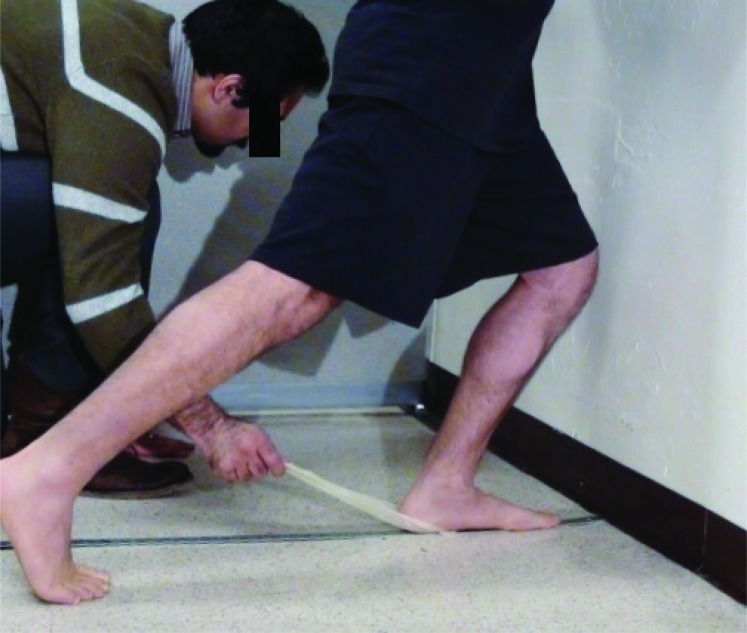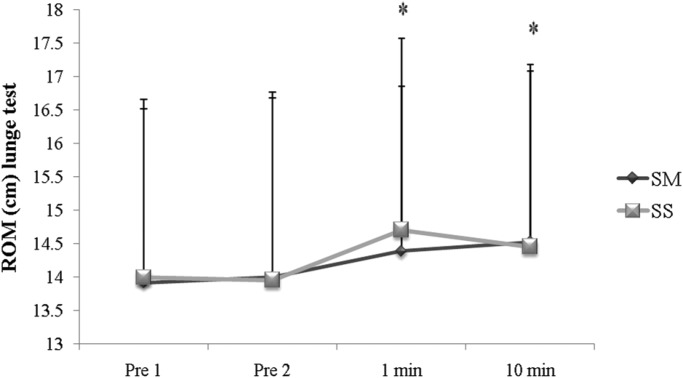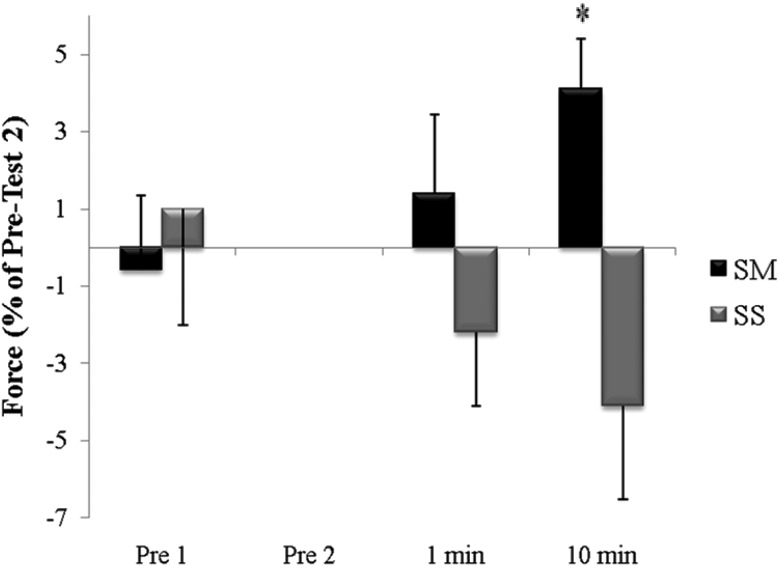Abstract
Background:
Limited dorsiflexion range of motion (ROM) has been linked to lower limb injuries. Improving limited ankle ROM may decrease injury rates. Static stretching (SS) is ubiquitously used to improve ROM but can lead to decreases in force and power if performed prior to the activity. Thus, alternatives to improve ROM without performance decrements are needed.
Objectives/Purpose:
To compare the effects of SS and self massage (SM) with a roller massage of the calf muscles on ankle ROM, maximal voluntary contraction (MVC) force F100 (force produced in the first 100 ms of the MVC), electromyography (EMG of soleus and tibialis anterior) characteristics of the plantar flexors, and a single limb balance test.
Methods:
Fourteen recreationally trained subjects were tested on two separate occasions in a randomized cross‐over design. After a warm up, subjects were assessed for passive dorsiflexion ROM, MVC, and a single‐limb balance test with eyes closed. The same three measurements were repeated after 10 minutes (min) of rest and prior to the interventions. Following the pre‐test, participants randomly performed either SS or SM for 3 sets of 30 seconds (s) with 10s of rest between each set. At one and 10 min post‐interventions the participants repeated the three measurements, for a third and fourth cycle of testing.
Results:
Roller massage increased and SS decreased maximal force output during the post‐test measurements, with a significant difference occurring between the two interventions at 10 min post‐test (p < 0.05, ES = 1.23, 8.2% difference). Both roller massage (p < 0.05, ES = 0.26, ~4%) and SS (p < 0.05, ES = 0.27, ~5.2%) increased ROM immediately and 10 min after the interventions. No significant effects were found for balance or EMG measures.
Conclusions:
Both interventions improved ankle ROM, but only the self‐massage with a roller massager led to small improvements in MVC force relative to SS at 10 min post‐intervention. These results highlight the effectiveness of a roller massager relative to SS. These results could affect the type of warm‐up prior to activities that depend on high force and sufficient ankle ROM.
Level of Evidence:
2c
Keywords: Dorsiflexion, electromyography, flexibility, self‐massage, strength
Introduction
The prevalence of lower limb injuries among athletes is extremely high accounting for 50% of all injuries among athletes from different sports.1 Limited dorsiflexion range of motion (ROM) has been identified as a risk factor for knee, ankle, shin and hamstring injuries among trained athletes.2,3,5,6,7 Furthermore, limited dorsiflexion was found to be associated with increased knee valgus during squatting,8 and greater ground reaction forces when landing from a jump.9 These biomechanical alternations strongly correlate with the possibility of ACL injuries.8,9,10 Accordingly, improving dorsiflexion ROM may reduce injury rates in the lower limbs among amateur and elite athletes alike.
One of the most common methods to improve ROM both acutely and chronically is static stretching (SS), however, a major limitation of SS is that it could lead to decreased power and force production if performed prior to an athletic activity.11 Another alternative, which has been growing in popularity, is self massage (SM) with either a foam roller or a roller massager.12 The individual uses the foam roller or roller massager to SM specific areas of the body, typically those prone to overuse and injuries, before or after a training session. Despite growing popularity, few studies to date have examined the effects of SM on ROM and muscle performance. A recent study found that two sets of one minute (min) of SM using a foam roller on the quadriceps muscles improved knee joint ROM for up to 10 min without a concomitant deficit in muscle performance.13 In the only published study examining the effects of a roller massager, it was demonstrated that subjects’ hip flexion ROM improved 4.3% immediately following both five and 10 seconds (s) of rolling their hamstrings.14 The effect of the roller massager on muscles other than the hamstrings has not been studied. Furthermore, Sullivan et al14 used a specialized device in their research to consistently provide thirteen kilograms of pressure while the roller massager was being used. It is currently not known if self‐administered rolling provides similar acute increases in flexibility as rolling with the constant pressure device. Although studies have shown that SS and SM are effective for increasing ROM, there have not been any studies performed for a direct comparison between SS and SM for ROM, balance, or muscle force production.
There is very little information on the effects of SS or massage on balance. Behm et al15 reported a 9.2% impairment of balance (number of floor contacts with a wobble board) following three sets of 45s of SS. Conversely, both a single sixty min full body massage and six weeks of therapeutic massage improved both static and dynamic balance (Center of pressure measures using a balance platform) in older adults.16,17 There are no studies documenting the effects of treatment using a roller massager on balance. Impairments to balance would have important consequences for health (fall prevention), work safety, and athletic performance.
Because there is a need to find effective and easy‐to‐use alternatives to stretching to improve ROM without performance decrements, the aim of this study was to compare the effects of SS and SM with a roller massage of the calf muscles on ankle ROM, plantar flexors’ maximal voluntary contraction (MVC) force and force produced in the first 100 ms of the MVC (F100), soleus and tibialis anterior electromyography (EMG) and single limb balance.
It was hypothesized that both interventions would improve ROM, but SS would reduce maximal force, F100, and soleus EMG, and decrease balance performance. In contrast, it was hypothesized that after the roller massager intervention maximal force, F100, EMG, and balance values would not be adversely affected.
Methods
Subjects
Based on a power analysis, fourteen subjects, twelve males (70.2 ± 10.4 kg, 175.1 ± 8.8 cm, 23 ± 4 years) and 2 females (56.7 ± 3.8 kg, 167.2 ± 2.5 cm, 22 ± 3 years) were recruited for the study. In order to be included, subjects had to perform a minimum 2 days a week of physical activity (at least 30 minutes of fitness activities such as resistance training or sport activity above the aerobic threshold) and have no lower limb injuries in the previous year. All subjects provided written consent prior to participation provided written and informed consent. Memorial University of Newfoundland Human Research Ethics Authority (HREA) approved this study (File number 12.241).
Experimental Approach
A randomized cross over design was used to compare the effect of SM using a roller massager (Thera‐Band, Hygienic Corporation, Akron, OH) and SS of the plantar flexor muscles. Measures included ankle ROM, plantar flexors MVC, F100, as well as EMG of the soleus and tibialis anterior muscles and balance (Figure 1).
Figure 1.

The experimental design of the study. Note: ↑ = measurement of ankle range of motion; ↕ = measurement of plantar flexors’ maximal voluntary contraction; ↓ = performance of the balance test. SM = Self Massage. SS = Static Stretching.
Subjects visited the lab on two different occasions, 3‐6 days apart. Each session began with a warm‐up consisting of 10 single‐legged heel raises while standing on a step. The pace of the concentric and eccentric contractions was controlled by a metronome set at 1 Hz. The subjects performed the dependent variables in the following order: ankle ROM, plantar flexors MVC (measures included maximum force, F100 and EMG), and the single‐limb balance test. All tests were performed barefoot and with the dominant leg (assessed as the leg used to kick a soccer ball). Subjects rested for 10 min before performing a second set of measurements to serve as a control trial before the interventions. Hence, there were 2 sets of pre‐tests. The first pre‐test immediately followed the 10 warm‐up contractions, which could have altered the phosphorylation of myosin light chains (post‐activation potentiation)18. Since myosin phosphorylation has been reported to subside 10 min following contractions18, the second pre‐test was used as the control baseline when comparing between the two interventions. Both pre‐tests were analyzed to determine if there were significant alterations due to the submaximal warm‐up contractions. After the second cycle of pre‐testing, participants performed 1 of the 2 interventions in a randomized order: SS or SM with a roller massager. Both interventions involved three repetitions of 30s with 10s rest between each repetition. At one and 10 minutes post‐interventions, participants performed a third and fourth cycle of testing.
Independent Variables
The Roller Massager by Theraband® is a portable device with dense foam wrapped around a solid plastic cylinder (Figure 2). Its ridged design purportedly allows for SM.19
Figure 2.
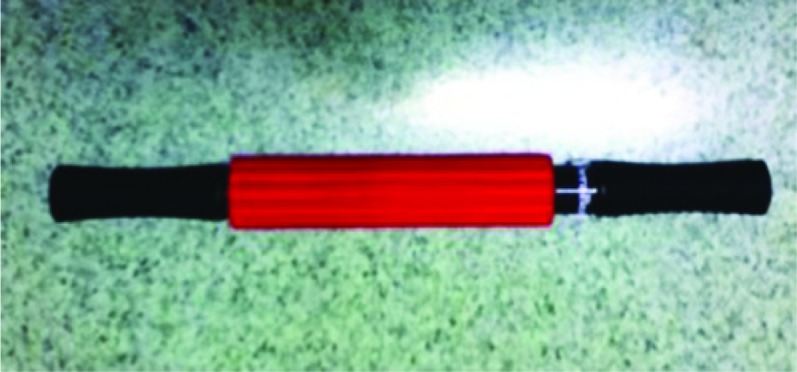
The roller massager used in this research (Theraband®, The Hygenic Corporation, Akron, OH).
Subjects were informed of the protocol and were instructed on how to use the roller massager prior to performing the warm‐up on the SM day. The roller massage protocol took place while the participants were seated on a chair with their knees flexed at 90 degrees. An aerobic step was placed underneath the heel of the leg being massaged in order to ensure slack of the calf muscles during the protocol. Subjects would then flex forward with their trunk to massage their calf muscles with the roller (Figure 3). Subjects were then introduced to the rate of perceived pain in which a score of one represented no pain at all and a score of 10 represented the maximum pain that can be tolerated as a result of rolling the calf. Consequently in order to orient the subjects to the perceived pain ratings, they were asked to practice rolling their non‐tested calf muscles at a pace of one second per roll (travel the length of the calf in 1 second), while practicing the application of pressure equivalent to a pain level of one, 5 and 10 (asked to induce maximal discomfort) respectively for three rolls each. Additionally, they were instructed to roll their entire muscle from origin to insertion and use different angles of the roller massager in order to target all areas of the calf. During the actual SM testing, subjects were instructed to apply pressure equivalent to a pain level of 7 out of 10.
Figure 3.
Position adopted during the self‐massage treatment with the roller massager.
For the SS intervention, subjects stood with one leg on the edge of an aerobic step while leaning against the wall with their hands. Their heel was pointing towards the ground and their knee extended (Figure 4). The intervention was performed with bare feet. Similar to the SM protocol, subjects were asked to stretch their calf muscles to a pain level of 7 out of 10.
Figure 4.
Static stretching position for the plantar flexors.
Dependent Variables
Maximal Voluntary Contraction (MVC)
A modified “boot” apparatus (Technical Services, Memorial University of Newfoundland) that has been validated and shown to be reliable in a number of studies from this laboratory20,21,22 was used to measure isometric MVC force and F100. Subjects were seated with the thigh horizontal to the floor and the knee joint flexed at 90 degrees. Straps and braces prevented extraneous movement of the upper and lower leg, and securely restrained the foot so that any attempt to dorsiflex and plantar flex the ankle joint resulted in an isometric contraction (Figure 5). The device was calibrated before each session by hanging known weights off the foot plate.
Figure 5.
Boot apparatus for measuring the maximal voluntary contraction with the plantar flexors.
During the first cycle of testing, participants were instructed how to perform a MVC and were asked to plantar flex their foot as fast and as forcefully as they could for duration of 3 s. Verbal encouragement was given during the MVC to motivate the subjects. Other than the first cycle of testing in which subjects performed 2 MVCs separated by one minute, subjects performed only one MVC in the following trials. The MVC was analyzed for peak force and force generated in the initial 100 milliseconds (ms)(F100).13
Electromyography (EMG)
Bipolar surface EMG electrodes were used to measure muscle activation (integral of the EMG over a three second period of the MVC that included the peak force) from the soleus and tibialis anterior muscles during the MVC test. Two surface EMG recording electrodes (Meditrace Pellet Ag/AgCl discs and 10 mm in diameter, Covidien, Canada) were placed 2 cm apart over the midpoint of the muscle bellies of the tibialis anterior and soleus with a ground electrode placed on the head of the fibula. The gastrocnemius was not monitored, as it is not the primary plantar flexor when in a flexed knee position.23 All skin surfaces where the electrodes were placed were shaved, abraded, and cleansed with alcohol to improve electrical conductivity.
EMG activity was sampled at 2000 Hz (Biopac System Inc., DA 100: analog‐digital converter MP150WSW; Holliston, Massachusetts), with a Blackman 61 dB bandpass filter between 10 and 500 Hz, amplified (bipolar differential amplifier, input impedance = 2 Mf, common mode rejection ratio [110 dB min (50/60 Hz), gain 1,000, noise [5 µV), and analog to digitally converted (12 bit) and were stored on a personal computer for further analysis. The rectified integral of the EMG signal was analyzed (AcqKnowledge III, Biopac System Inc.) over a three second period of the MVC that included the peak force.
Range of motion (ROM)
A weight bearing lunge test was used to assess ankle dorsiflexion. Subjects stood with their foot perpendicular to the wall and flexed their knee until it touched the wall in a straight line and without the heel coming off the ground.24 The foot progressively moved towards or away from the wall according to the success (knee contact with wall) of the previous trial (Figure 6). If the knee touched the wall in a straight line and the heel did not come off the ground then subjects were asked to move their foot back by 0.5 centimeters. A ruler that was attached to the floor measured the distance between the knee and wall. Subjects were asked to stand with their big toe behind the centimeter lines as they moved back or forward. To monitor any elevation of the heel, a Theraband band was placed under the participant’s heel, which was pulled by the same experimenter during the test. This way if the heel raised off the floor the band snapped away. The in line weight bearing ankle ROM test has been found to have high inter‐rater (r = 0.99) and intra‐rater (r = 0.98) reliability.24 Test sensitivity was 0.5 cm based on the visual inspection of the researcher.
Figure 6.
In‐line lunge testing procedure.
Figure 7.
Range of motion (cm) in Lunge Test. SM = Self Massage. SS = Static Stretching. * = Significantly greater than both Pre‐test 1 and Pre‐test 2.
Balance
The time to failure of the Stork single limb balance test was used to measure static balance. Subjects were asked to stand on their dominant foot while having their hands on the iliac crest and eyes closed for 30s. The test was terminated at 30s. The time to failure was recorded when the subject lifted the medial or lateral border of the foot, lifted hands off the iliac crest, lifted forefoot or heel, stepped or stumbled, moved the weight‐bearing foot from original position, or opened his or her eyes.25,26 Stork test inter‐rater reliability has previously been reported as 0.95.27
Statistical analysis
Statistical analyses were computed using SPSS software (SPSS 17.0 for Windows Inc., Chicago, IL). Intra‐class correlation coefficient (ICC) was computed for four pre‐tests (two for each testing session) for the following variables: Force, F‐100, ROM, Stork single limb balance test, and EMG of the soleus and tibialis anterior.
Within conditions
The effects of each intervention (SM and SS) were measured with a one‐way repeated measures analysis of variance (ANOVA) across the 4 time intervals (two pre‐tests and two post‐tests) for all outcome variables. If the assumption of Sphericity was violated, the Greenhouse‐Geisser correction was employed. Paired t‐tests with a Holm‐Bonferroni correction were used to identify differences between mean results if a significant main effect was found.
Between conditions (SM vs. SS)
In order to compare the effects of the two interventions, the value in each time interval (pre‐test one, 1 minute and 10 minutes post‐test) was normalized based on pre‐test two. The value of pre‐test two was chosen for normalization because it was preceded by 10 minutes of rest, whereas the value of pre‐test one could have been affected by the primary warm‐up protocol. Thereafter, a two‐way repeated measures ANOVA (2 conditions × 3 time intervals) was conducted to compare the normalized values between the two interventions. If an interaction was found, paired t‐tests with a Holm‐Bonferroni correction were used to compare the normalized values between the 2 conditions. Significance was set at p < 0.05. Cohen’s d effect sizes (ES) were calculated when significant results were found.
Results
The ICC’s for force, ROM, and Stork single limb balance test were 0.91, 0.98 and 0.68,respectively. Additionally, the ICC’s of the EMG were 0.8 and 0.87 for tibialis anterior and soleus respectively.
Based on the collected data (means and standard deviations), the statistical power with 14 subjects achieved a power of 0.4, 0.7, 0.84, 0.84 and 0.84 for F100, single limb balance, EMG, ROM, and MVC force respectively.
Within conditions
SS
A significant time effect was found for ROM (, p = 0.001). Paired t‐tests revealed that ROM was significantly greater immediately after the intervention when compared with pre‐test one (p = 0.004, ES = 0.26, 5%) and pre‐test two (p = 0.001, ES = 0.27, 5.4%). No significant main effects were found for Force, F‐100, EMG of soleus and tibialis anterior, and balance.
SM
A significant time effect was found for ROM (, p = 0.001). Paired t‐tests revealed that ROM was significantly greater immediately (p = 0.004, ES = 0.24, 3.6%) and 10 minutes after (p = 0.006, ES = 0.26, 4.4%) when compared with pre‐test one. No significant main effects were found for force, F‐100, EMG of soleus and tibialis anterior, and balance.
Between conditions
A significant interaction was found between conditions for force (, p = 0.040). Paired t‐tests revealed that during the SM trial subjects produced significantly greater normalized force relative to SS at 10 min post (p = 0.005, ES = 1.23, 8.2%). No significant differences were found between the two conditions for ROM, F‐100, EMG and balance with the normalized values.
Discussion
The main findings of the present study were that both SS and roller massage significantly improved ankle ROM to a similar degree at one and 10 min post‐intervention. Secondly, the SM protocol led to a significant improvement in force production at the 10 min post‐test measurement, relative to the SS protocol. Finally, F‐100, balance and EMG values were not affected by either intervention.
The finding of improved dorsiflexion ROM as a result of SS (~5.2%) is similar to other studies that measured the effects of SS on dorsiflexion ROM.28,29 Ryan et al28 found that two, four, and eight minutes of SS of the dorsiflexors improved ROM by 8%, 14% and 13% respectively. However, ROM returned to baseline 10 min post‐stretching under all conditions.28 In another study it was found that seven min of SS led to immediate improvements of 27% in dorsiflexion ROM relative to a control group.29 The ROM difference between the studies may be related to the stretch type, duration, intensity, or measurements techniques. Stretching in various studies has been induced with an isokinetic dynamometer,28 a 51 pound load to dorsiflex the foot,29 and by standing on a step in the current study. The duration and rest intervals were four sets of 30s with 20s of rest between sets,28 constant stretch lasting seven min,29 and three sets of 30s with 10s of rest between each set in the current study. The ROM measurements used in these studies were an open chain test using an isokinetic dynamometer,28 active ROM measurements taken with a goniometer,29 and a closed chain test using the in line lunge in the present study. Lastly, stretch intensity was variably defined between studies as the point of discomfort, but not pain,28 no definition of pain or tolerance,29 and a pain level of 7 out 10. Hence due to the variety of methodologies employed it is impossible to pinpoint the exact mechanisms explaining the differences in study outcomes. The immediate results of Ryan et al28 were somewhat similar to the current study, perhaps because of the relative similarities in the duration of the stretches. However, despite a decrease in ROM 10 min after the intervention in the current study, the ROM values were still higher relative to baseline in contrast to Ryan et al.28
Table 1.
Mean (SD) for Various Measurement of Self‐Massage (SM) and Static Stretching (SS) During Different Time Intervals.
| Variable | Condition | Pre‐test 1 | Pre‐test 2 | 1 minute | 10 minutes |
|---|---|---|---|---|---|
| F‐100 (Newtons) | SM | 234.56 (81.30) | 221.50 (61.49) | 252.96 (72.30) | 219.93 (60.39) |
| SS | 268.62 (103.15) | 267.70 (77.5) | 258.73 (72.73) | 267.78 (101.66) | |
| IEMG‐TA (millivolts) | SM | 0.003 (0.001) | 0.004 (0.001) | 0.004 (0.001) | 0.004 (0.001) |
| SS | 0.004 (0.001) | 0.004 (0.001) | 0.003 (0.001) | 0.003 (0.001) | |
| IEMG‐SOLEUS (millivolts) | SM | 0.02 (0.00) | 0.02 (0.01) | 0.02 (0.01) | 0.02 (0.01) |
| SS | 0.02 (0.01) | 0.02 (0.01) | 0.02 (0.01) | 0.02 (0.01) | |
| Stork Test (seconds) | SM | 29.72 (0.90) | 29.08 (0.75) | 26.63 (5.86) | 27.05 (5.56) |
| SS | 27.22 (3.72) | 27.63 (4.41) | 23.58 (7.06) | 25.75 (6.55) |
F100 = force produced in the first 100 milliseconds; IEMG = Integrated electromyography; TA= tibialis anterior
Improved ROM as a result of the roller massager in the current study (~4%) is also consistent with the literature.13,14 MacDonald et al13 found that two sets of SM of the quadriceps using a foam roller led to increased knee flexion ROM by 10% and 8% following two and 10 minutes. Sullivan et al14 found a 4.6% increase in hamstring ROM following two sets of SM with a roller massager. The differences in the reported ROM changes may be muscle or joint dependent or related to the length of the SM bouts, which varied between 20s,14 two minutes13 and one minute, as compared to 30 s in the current study. Two other possible reasons for the differences may be related to the intensity and the muscle being massaged. Sullivan et al14 used a constant load device in which 13 kilograms of force was applied with each stroke on the hamstring muscle. In contrast, in the current study a constant RPE was used which did not objectively control for the applied loaded with each stroke. In the MacDonald et al13 study, subjects were asked to apply as much of their bodyweight on the foam roller but RPE and applied tension were not controlled. Lastly, all three studies used different muscle groups: the quadriceps, hamstring and calf muscles, which may respond differently to SM interventions.
The significantly improved ROM, despite being similar in both conditions (SS and roller massager), may originate from different mechanisms or a combination of causes. One possibility explaining the results, especially the ROM measurements taking place one minute after the SS intervention, are changes in the viscoelastic properties of muscle‐tendon unit.30,31,32,33 When a muscle is stretched, a shift occurs in its force‐length relationship.30,31 That is, the passive force at the specific length gradually declines which reduces the stiffness of the muscle‐tendon unit.30,31 Studies have reported that SS of the plantar flexors lasting between one and 20 min significantly reduces musculotendinous stiffness.30,31,33,33 However, other authors who have measured the length of time it takes musculotendinous stiffness to return to baseline values report fast recovery times ranging between 30s to one hour.31,32,33,34,35,36 A second explanation for the improved ROM is an increased stretch tolerance.37 Since the actual biomechanical changes are of short duration, some researchers suggest that the main reason for improved ROM has to do with the participants’ acquired ability to tolerate greater levels of stretching37. This is supported by the results of several studies that demonstrate improved ROM in subjects, without a concomitant change in the force‐length relationship.38,39,40 It is likely that the improved ROM under the SS and roller massager conditions is a result of a combination of changes in the musculotendinous properties and tolerance to the stretch. Currently more research is needed to pinpoint which of the mechanisms influence ROM and how they interact with each other.
The effects of the interventions on force are partly in accordance with the stated hypothesis. Subjects were able to produce significantly greater forces after the SM trial in comparison to the SS trial (8.2%). Figure 8 illustrates that SS tended to decrease MVC values whereas SM tended to increased MVC values at 10 minutes. Other authors who examined the effects of SS on plantar flexor MVCs did not find significant negative effects on MVC values when using moderate duration of SS ranging between two and three minutes.41,42 A dose‐response relationship may exist in which longer durations of SS will lead to significant decreases in force production.11 For example, Fowles et al43 reported a meaningful reduction in MVC (28%) after performing 30 min of SS.
Figure 8.
Relative changes in plantar flexion force as a % of pre‐test 2. SM = Self Massage. SS = Static Stretching. * = SM is significantly greater than SS.
Possible mechanisms regarding the SS‐induced MVC decrements relative to SM may relate to changes in the length–tension relationship in the muscle, which could negatively influence the crossbridge overlap.44,45 Additional stretching‐induced decreases in force may be due to a nervous system inhibitory mechanism. This explanation is based on studies that found a concomitant decreases in muscle force production and a reduction in EMG values and reflex responses of that muscle.46,47,48 However, no reductions in EMG values were found in the present study and it is therefore more likely that the effects on force were related to changes in the length–tension relationship in the muscle.
SM with the roller massager led to increases in MVC force relative to SS, which reached significance at 10 minutes post treatment. This finding is somewhat similar to the two SM studies in which no impairment or augmentation in muscle performance was noted after the application of stretch using a roller massager.13,14 Possible explanations to the slight but non‐significant improvement in force production may relate to increases in muscle temperature,49,50,51 a “release” of myofascial restrictions (also known as trigger points) in the calf muscles,52 and/or phosphorylation of the myosin regulatory light chains.53 The significant differences in force between SS and SM at 10 min post‐intervention are likely due to a combination of some or all of the abovementioned factors.
Balance was unaffected by both of the interventions. The lack of effect on balance as a result of SS is in agreement with Costa et al54 but not with Behm et al.15 Behm et al15 found that three sets of SS lasting 45s of three different muscle groups (quadriceps, hamstrings and calf muscles) decreased the balance scores by 9.2%. Costa et al54 used the same SS protocol as Behm et al,15 but compared two durations of stretch being held: 15 and 45s. It was found that 15s of SS led to improved balance scores, while 45s did not affect the results. The conflicting outcomes may be explained by the different testing devices and the gender of the subjects. The testing devices used in the studies were a computerized wobble board,15 a Biodex Balance system54 and a Stork balance test in the present study (non‐computerized). The gender of the subjects also differed between studies. Costa et al54 only had female subjects in contrast to Behm et al15 who exclusively used males. Similarly, the subjects in the present were mostly male (12 out of 14). To the best of the authors’ knowledge the present study is the first to explore the effects of roller massager on balance, and more studies are needed to verify the effects of SM with a roller massager and SS on balance.
A limitation of this study is the small sample size, increasing the risk of Type II statistical errors. A strength of the current study, however, is the utilization of a cross‐over design in which each participant acted as his own control in a randomized manner. This design markedly increases the statistical power study with a small sample size.
Conclusions
The results of the present study demonstrated that both SS and SM with the roller massager significantly improved ROM in the ankle joint up to 10 min after the interventions by approximately 4%. In contrast, SM with the roller massager led to significantly greater force production relative to SS (8.2%). SS led to a small and statistically insignificant decrease in MVC (~4%), while SM with the roller massager led to small increase in MVC 10 min after the intervention of approximately 4%. Both SS and roller massage did not affect balance scores. Accordingly, both roller massage and SS led to similar improvements in ROM, however with the SM‐induced increase in subsequent force relative to SS, the use of a roller massage prior to an activity that relies on maximum strength and power may be advantageous.
References
- 1.Hootman JM, Dick R, Agel J. Epidemiology of Collegiate Injuries for 15 Sports: Summary and Recommendations for Injury Prevention Initiatives. J Athl Train. 2007; 42: 311–319 [PMC free article] [PubMed] [Google Scholar]
- 2.Witvrouw E, Lysens R, Bellemans J, et al. Intrinsic Risk Factors For the Development of Anterior Knee Pain in an Athletic Population: A Two‐Year Prospective Study. Am J Sports Med. 2000; 28: 480–489 [DOI] [PubMed] [Google Scholar]
- 3.Piva SR, Goodnite EA, Childs JD. Strength Around the Hip and Flexibility of Soft Tissues in Individuals With and Without Patellofemoral Pain Syndrome. J Orthop Sports Phys Ther. 2005; 35: 793–801 [DOI] [PubMed] [Google Scholar]
- 4.Pope R, Herbert R, Kirwan J. Effect of ankle dorsiflexion range and pre‐exercise calf muscle stretching on injury risk in Army recruits. Aust J Physiother. 1998; 44(3): 165–172 [DOI] [PubMed] [Google Scholar]
- 5.Kaufman KR, Brodine SK, Shaffer RA, et al. The Effect of Foot Structure and Range of Motion on Musculoskeletal Overuse Injuries. Am J Sports Med. 1999; 27: 585–593 [DOI] [PubMed] [Google Scholar]
- 6.Gabbe BJ, Finch CF, Wajswelner H, Bennell KL. Predictors of Lower Extremity Injuries at the Community Level of Australian Football. Clin J Sport Med. 2004; 14: 56–63 [DOI] [PubMed] [Google Scholar]
- 7.Gabbe BJ, Bennell KL, Finch CF, et al. Predictors of hamstring injury at the elite level of Australian football. Scand J Med Sci Sports. 2006; 16: 7–13 [DOI] [PubMed] [Google Scholar]
- 8.Bell DR, Padua DA, Clark MA. Muscle Strength and Flexibility Characteristics of People Displaying Excessive Medial Knee Displacement. Arch Phys Med Rehabil. 2008; 89: 1323–8 [DOI] [PubMed] [Google Scholar]
- 9.Fong CM, Blackburn JT, Norcross MF, et al. Ankle‐dorsiflexion range of motion and landing biomechanics. J Athl Train. 2011; 46(1): 5–1 [DOI] [PMC free article] [PubMed] [Google Scholar]
- 10.Hewett TE, Ford KR, Hoogenboom BJ, Myer GD. Understanding and prevention of ACL injuries: current biomechanical and epidemiologic considerations‐update 2010. N Am J Sports Phys Ther. 2010; 5: 234–251 [PMC free article] [PubMed] [Google Scholar]
- 11.Behm DG, Chaouachi A. A review of the acute effects of static and dynamic stretching on performance. Eur J Appl Physiol. 2011; 111: 2633–51 [DOI] [PubMed] [Google Scholar]
- 12.Boyle M. Using Foam Rollers. http://www.performbetter.com/webapp/wcs/stores/servlet/PBOnePieceView?storeId=10151&pagename=225 [Google Scholar]
- 13.MacDonald GZ, Penney MD, Mullaley ME, et al. An Acute Bout of Self‐Myofascial Release Increases Range of Motion Without a Subsequent Decrease in Muscle Activation or Force. J Strength Cond Res. 2005; 27: 812–821 [DOI] [PubMed] [Google Scholar]
- 14.Sullivan KM, Silvey DB, Button DC, Behm DG. Roller‐Massager application to the hamstrings increases sit‐and reach range of motion within five to ten seconds without performance impairments. Int J Sports PhysTher. 2013; 8: 228–236 [PMC free article] [PubMed] [Google Scholar]
- 15.Behm DG, Bambury A, Cahill F, Power K. Effect of acute static stretching on force, balance, reaction time, and movement time. Med Sci Sports Exerc. 2004; 36: 1397–1402 [DOI] [PubMed] [Google Scholar]
- 16.Sefton JM, Yarar C, Berry JW. Six weeks of massage therapy produces changes in balance, neurological and cardiovascular measures in older persons. Int J Ther Massage Bodywork. 2012; 5(3): 28–40 [DOI] [PMC free article] [PubMed] [Google Scholar]
- 17.Sefton JM, Yarar C, Berry JW. Massage Therapy Produces Short‐term Improvements in Balance, Neurological, and Cardiovascular Measures in Older Persons. Int J Ther Massage Bodywork. 2012; 5: 16–27 [DOI] [PMC free article] [PubMed] [Google Scholar]
- 18.Houston ME, Grange RW. Myosin phosphorylation, twitch potentiation, and fatigue in human skeletal muscle. Can J Physiol Pharmacol. 1990; 68: 908–913 [DOI] [PubMed] [Google Scholar]
- 19.Thera‐Band: Systems of Progressive Exercise Roller Massager Standard Version. http://www.thera‐band.com/store/products.php?ProductID=82
- 20.Behm DG, Sale DG. Intended rather than actual movement velocity determines velocity‐specific training response. J Appl Physiol. 1993; 74: 359–68 [DOI] [PubMed] [Google Scholar]
- 21.Drinkwater EJ, Behm DG. Effects of 22°C muscle temperature on voluntary and evoked muscle properties during and after high‐intensity exercise.ApplPhysiolNutrMetab. 2007; 32: 043–1051 [DOI] [PubMed] [Google Scholar]
- 22.Behm D. G, Whittle J, Button D., Power K. Intermuscle differences in activation. Muscle nerve. 2002; 25: 236–243 [DOI] [PubMed] [Google Scholar]
- 23.Ballantyne BT, Kukulka GL, Soerberg GL. Motor unit recruitment in human medial gastrocnemius muscle during combined knee flexion and plantar flexion isometric contractions. Exp Brain Res. 1993; 3: 492–498 [DOI] [PubMed] [Google Scholar]
- 24.Bennell KL, Talbot RC, Wajswelner H. Intra‐rater and inter‐rater reliability of a weight‐bearing lunge measure of ankle dorsiflexion. Aust J Physiother. 1998; 44: 175–180 [DOI] [PubMed] [Google Scholar]
- 25.Ricotti L, Static and dymanic balance in young athletes. J Hum Sport Exer. 2011; 6 (4), 616–628 [Google Scholar]
- 26.Riemann BL. Is there a link between chronic ankle instability and postural instability? J Athl Train. 2002; 37: 386–393 [PMC free article] [PubMed] [Google Scholar]
- 27.Atwater SW, Crowe TK, Deitz JC, Richardson PK. Interrater and test‐retest reliability of two pediatric balance tests. PhysTher. 1990; 70: 79–87 [DOI] [PubMed] [Google Scholar]
- 28.Ryan E, Beck T, Herda T, et al. Do practical durations of stretching alter muscle strength? A dose‐response study. Med Sci Sports Exerc. 2008; 40: 15–29 [DOI] [PubMed] [Google Scholar]
- 29.Wessling KC, DeVane DA, Hylton CR. Effects of static stretch versus static stretch and ultrasound combined on triceps surae muscle extensibility in healthy women. Phys ther. 1987; 67: 674–679 [DOI] [PubMed] [Google Scholar]
- 30.Gajdosik RL. Passive extensibility of skeletal muscle: review of the literature with clinical implications. Clin biomech. 2001; 16: 87–101 [DOI] [PubMed] [Google Scholar]
- 31.Morse CI, Degens H, Seynnes OR, et al. The acute effect of stretching on the passive stiffness of the human gastrocnemius muscle tendon unit. J Physiol. 2008; 586: 97–106 [DOI] [PMC free article] [PubMed] [Google Scholar]
- 32.Ryan ED, Herda TJ, Costa PB, et al. Determining the minimum number of passive stretches necessary to alter musculotendinous stiffness. J sports sci. 2009; 27: 957–961 [DOI] [PubMed] [Google Scholar]
- 33.McNair PJ, Dombroski EW, Hewson DJ, Stanley SN. Stretching at the ankle joint: viscoelastic responses to holds and continuous passive motion. Med Sci Sports Exerc. 2001; 33: 354. [DOI] [PubMed] [Google Scholar]
- 34.Magnusson SP, Simonsen EB, Aagaard P, Sørensen H, et al. A mechanism for altered flexibility in human skeletal muscle. J physiol. 1996; 497: 291–298 [DOI] [PMC free article] [PubMed] [Google Scholar]
- 35.Magnusson SP, Aagaard P, Nielson JJ. Passive energy return after repeated stretches of the hamstring muscle‐tendon unit. Med Sci Sports Exerc. 2000; 32: 1160–1164 [DOI] [PubMed] [Google Scholar]
- 36.Magnusson SP, Simonsen EB, Aagaard P, Gleim GW, et al. Viscoelastic response to repeated static stretching in the human hamstring muscle. Scand j med sci sports. 1995; 5: 342–347 [DOI] [PubMed] [Google Scholar]
- 37.Weppler CH, Magnusson SP. Increasing muscle extensibility: a matter of increasing length or modifying sensation? Phys Ther. 2010; 90: 438–449 [DOI] [PubMed] [Google Scholar]
- 38.Ylinen J, Kankainen T, Kautiainen H, Rezasoltani A, et al. Effect of stretching on hamstring muscle compliance. J Rehabil Med. 2009; 41: 80–84 [DOI] [PubMed] [Google Scholar]
- 39.Ben M, Harvey LA. Regular stretch does not increase muscle extensibility: a randomized controlled trial. Scand j med sci sports. 2010; 20: 136–144 [DOI] [PubMed] [Google Scholar]
- 40.Nakamura M, Ikezoe T, Takeno Y, Ichihashi N. Effects of a 4‐week static stretch training program on passive stiffness of human gastrocnemius muscle‐tendon unit in vivo. Eur j appl physiol. 2012; 112: 2749–2755 [DOI] [PubMed] [Google Scholar]
- 41.Young W, Elias G, Power J. Effects of static stretching volume and intensity on plantar flexor explosive force production and range of motion. J Sports Med Phys Fitness. 2006; 46: 403–411 [PubMed] [Google Scholar]
- 42.Cannavan D, Coleman DR, Blazevich AJ. Lack of effect of moderate‐duration static stretching on plantar flexor force production and series compliance. Clin Biomech. 2012; 27: 306–312 [DOI] [PubMed] [Google Scholar]
- 43.Fowles JR, Sale DG, MacDougall JD. Reduced strength after passive stretch of the human plantarflexors. J Appl Physiol. 2000; 89: 1179–1188 [DOI] [PubMed] [Google Scholar]
- 44.Kokkonen J, Nelson AG, Cornwell A. Acute muscle stretching inhibits maximal strength performance. Res Q Exerc Sport. 1998; 69: 411–415 [DOI] [PubMed] [Google Scholar]
- 45.Rassier DE, MacIntosh BR, Herzog W. Length dependence of active force production in skeletal muscle. J Appl Physiol. 1999; 86: 1445–1457 [DOI] [PubMed] [Google Scholar]
- 46.Cramer JT, Housh TJ, Weir JP, Johnson GO, et al. The acute effects of static stretching on peak torque, mean power output, electromyography, and mechanomyography. Eur J Appl Physiol. 2005; 93; 530–9 [DOI] [PubMed] [Google Scholar]
- 47.Behm DG, Button DC, Butt JC. Factors affecting force loss with prolonged stretching. Can J Appl Physiol. 2001; 26: 261–72 [PubMed] [Google Scholar]
- 48.Avela J, Kyröläinen H, Komi PV. Altered reflex sensitivity after repeated and prolonged passive muscle stretching. J Appl Physiol. 1999; 86: 1283–1291 [DOI] [PubMed] [Google Scholar]
- 49.Drust B, Atkinson G, Gregson W, et al. The effects of massage on intra muscular temperature in the vastus lateralis in humans. Int J Sports Med. 2003; 24: 395–399 [DOI] [PubMed] [Google Scholar]
- 50.Sargeant AJ. Effect of muscle temperature on leg extension force and short‐term power output in humans. Eur J Appl Physiol. 1987; 56: 693–698 [DOI] [PubMed] [Google Scholar]
- 51.Binkhorst RA, Hoofd L, Vissers AC. (1977). Temperature and force‐velocity relationship of human muscles. J Appl Physiol. 1997; 42: 471–475 [DOI] [PubMed] [Google Scholar]
- 52.Bron C, Dommerholt JD. Etiology of Myofascial Trigger Points. Curr Pain Headache Rep. 2012; 16: 439–444 [DOI] [PMC free article] [PubMed] [Google Scholar]
- 53.MacIntosh BR. Cellular and whole muscle studies of activity dependent potentiation. AdvExp Med Biol. 2010; 682: 315–42 [DOI] [PubMed] [Google Scholar]
- 54.Costa PB, Graves BS, Whitehurst M, Jacobs PL. The acute effects of different durations of static stretching on dynamic balance performance. J Strength Cond Res. 2009; 23: 141–147 [DOI] [PubMed] [Google Scholar]



